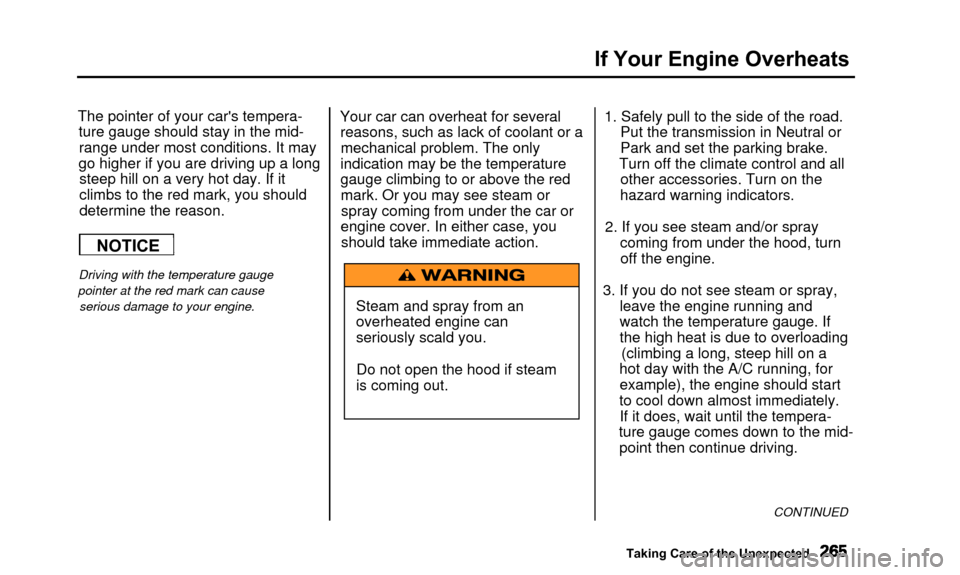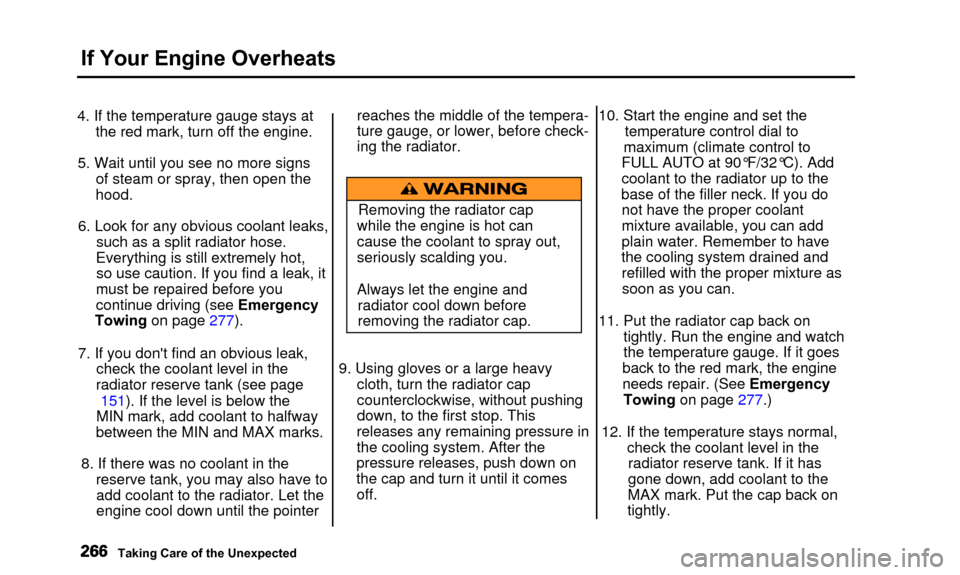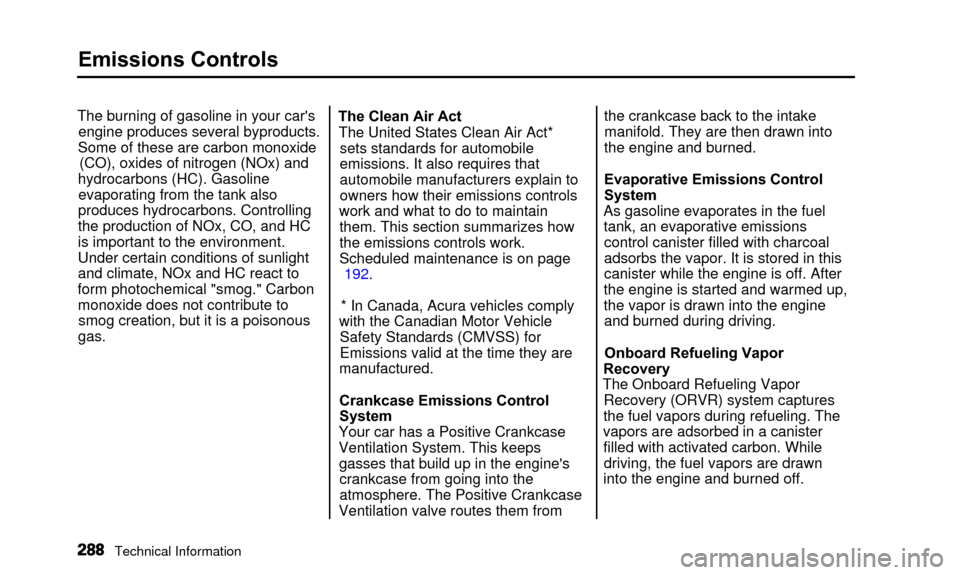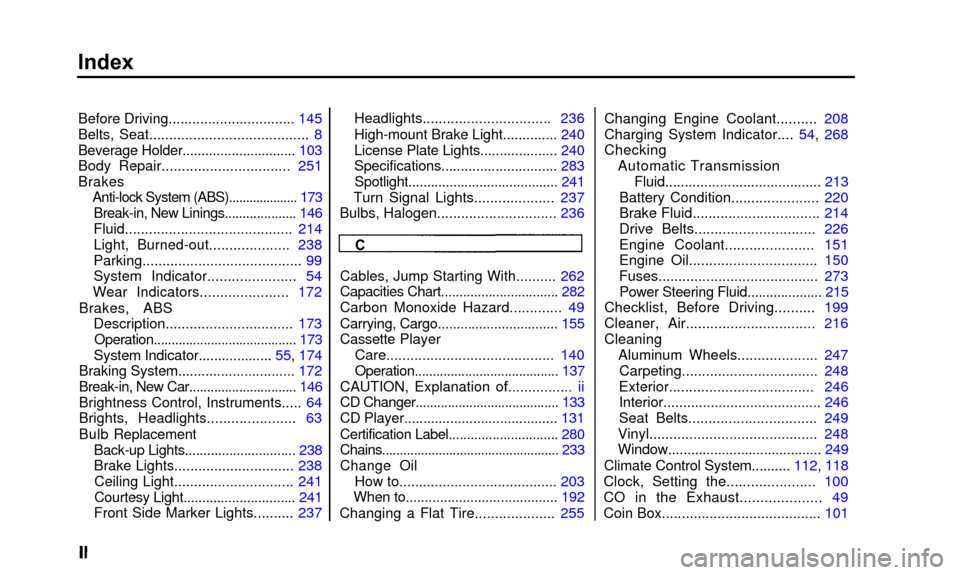climate control Acura TL 2000 3.2 Owner's Guide
[x] Cancel search | Manufacturer: ACURA, Model Year: 2000, Model line: TL, Model: Acura TL 2000Pages: 311, PDF Size: 3.05 MB
Page 266 of 311

Jump Starting
To jump start your car, follow thesedirections closely:
1. Open the hood and check the physical condition of the battery(see page 220). In very cold
weather, check the condition of
the electrolyte. If it seems slushy or like ice, do not try jump starting
until it thaws.
NOTICE
If a battery sits in extreme cold, the
electrolyte inside can freeze.
Attempting to jump start with a frozen battery can cause it to rupture.
2. Turn off all the electrical acces- sories: climate control, stereo
system, lights, etc.
Put the transmission in Neutral or
Park and set the parking brake. 3. Remove the battery cover.
4. Connect one jumper cable to the positive (+) terminal on the
booster battery. Connect the otherend to the positive (+) terminal
on your Acura's battery. 5. Connect the second jumper cable
to the negative (—) terminal on
the booster battery. Connect theother end to the grounding strap
as shown. Do not connect this
jumper cable to any other part of the engine.
CONTINUED
Taking Care of the Unexpected
Page 268 of 311

If Your Engine Overheats
The pointer of your car's tempera-ture gauge should stay in the mid-range under most conditions. It may
go higher if you are driving up a long steep hill on a very hot day. If it
climbs to the red mark, you should
determine the reason.
Driving with the temperature gauge
pointer at the red mark can cause serious damage to your engine.
Your car can overheat for severalreasons, such as lack of coolant or amechanical problem. The only
indication may be the temperature
gauge climbing to or above the red mark. Or you may see steam orspray coming from under the car or
engine cover. In either case, you should take immediate action.
Steam and spray from an
overheated engine can
seriously scald you.Do not open the hood if steam
is coming out. 1. Safely pull to the side of the road.
Put the transmission in Neutral or
Park and set the parking brake.
Turn off the climate control and all other accessories. Turn on the
hazard warning indicators.
2. If you see steam and/or spray coming from under the hood, turnoff the engine.
3. If you do not see steam or spray, leave the engine running and
watch the temperature gauge. If
the high heat is due to overloading(climbing a long, steep hill on a
hot day with the A/C running, for example), the engine should start
to cool down almost immediately. If it does, wait until the tempera-
ture gauge comes down to the mid- point then continue driving.
CONTINUED
Taking Care of the Unexpected
NOTICE
Page 269 of 311

If Your Engine Overheats
4. If the temperature gauge stays atthe red mark, turn off the engine.
5. Wait until you see no more signs of steam or spray, then open the
hood.
6. Look for any obvious coolant leaks, such as a split radiator hose.
Everything is still extremely hot, so use caution. If you find a leak, it
must be repaired before you
continue driving (see Emergency
Towing on page 277).
7. If you don't find an obvious leak, check the coolant level in the
radiator reserve tank (see page
151). If the level is below the
MIN mark, add coolant to halfway
between the MIN and MAX marks.
8. If there was no coolant in the reserve tank, you may also have toadd coolant to the radiator. Let the
engine cool down until the pointer reaches the middle of the tempera-
ture gauge, or lower, before check-
ing the radiator.
Removing the radiator cap
while the engine is hot can
cause the coolant to spray out,
seriously scalding you.
Always let the engine and radiator cool down before
removing the radiator cap.
9. Using gloves or a large heavy cloth, turn the radiator cap
counterclockwise, without pushing
down, to the first stop. This
releases any remaining pressure in
the cooling system. After the
pressure releases, push down on
the cap and turn it until it comes off. 10. Start the engine and set the
temperature control dial to
maximum (climate control to
FULL AUTO at 90°F/32°C). Add
coolant to the radiator up to the
base of the filler neck. If you do not have the proper coolant
mixture available, you can add
plain water. Remember to have
the cooling system drained and refilled with the proper mixture assoon as you can.
11. Put the radiator cap back on tightly. Run the engine and watch
the temperature gauge. If it goes
back to the red mark, the engine
needs repair. (See Emergency
Towing on page 277
.)
12. If the temperature stays normal, check the coolant level in theradiator reserve tank. If it has
gone down, add coolant to the
MAX mark. Put the cap back on
tightly.
Taking Care of the Unexpected
Page 287 of 311

DOT Tire Quality Grading (U.S. Cars)
The tires on your car meet all U.S.Federal Safety Requirements. All
tires are also graded for treadwear,
traction, and temperature perform-ance according to Department of
Transportation (DOT) standards.
The following explains these gradings.
Uniform Tire Quality Grading Quality grades can be found where
applicable on the tire sidewall
between the tread shoulder and the maximum section width. For
example:
Treadwear 200
Traction AA
Temperature A Treadwear
The treadwear grade is a compara-
tive rating based on the wear rate of
the tire when tested under controlledconditions on a specified government
test course. For example, a tire
graded 150 would wear one and one
half (1-1/2) times as well on the
government course as a tire graded 100. The relative performance of
tires depends upon the actual condi-
tions of their use, however, and may depart significantly from the norm
due to variations in driving habits,
service practices, and differences in
road characteristics and climate. Traction
The traction grades, from highest to
lowest, are AA, A, B, and C. Those
grades represent the tire's ability tostop on wet pavement as measured
under controlled conditions on specified government test surfaces
of asphalt and concrete. A tire
marked C may have poor traction
performance.
Warning: The traction grade assigned to this tire is based onstraight-ahead braking traction tests,
and does not include acceleration,
cornering, hydroplaning, or peak
traction characteristics.
Technical Information
Page 291 of 311

Emissions Controls
The burning of gasoline in your car'sengine produces several byproducts.
Some of these are carbon monoxide (CO), oxides of nitrogen (NOx) and
hydrocarbons (HC). Gasoline evaporating from the tank also
produces hydrocarbons. Controlling the production of NOx, CO, and HC
is important to the environment.
Under certain conditions of sunlight
and climate, NOx and HC react to
form photochemical "smog." Carbon monoxide does not contribute tosmog creation, but it is a poisonous
gas. The Clean Air Act
The United States Clean Air Act* sets standards for automobile
emissions. It also requires that
automobile manufacturers explain to
owners how their emissions controls
work and what to do to maintain them. This section summarizes how
the emissions controls work.
Scheduled maintenance is on page 192.
* In Canada, Acura vehicles comply
with the Canadian Motor Vehicle Safety Standards (CMVSS) for
Emissions valid at the time they are
manufactured.
Crankcase Emissions Control
System
Your car has a Positive Crankcase
Ventilation System. This keeps gasses that build up in the engine'scrankcase from going into the
atmosphere. The Positive Crankcase
Ventilation valve routes them from the crankcase back to the intake
manifold. They are then drawn into
the engine and burned.
Evaporative Emissions Control
System
As gasoline evaporates in the fuel tank, an evaporative emissionscontrol canister filled with charcoal
adsorbs the vapor. It is stored in this
canister while the engine is off. After
the engine is started and warmed up,
the vapor is drawn into the engine and burned during driving.
Onboard Refueling Vapor
Recovery
The Onboard Refueling Vapor Recovery (ORVR) system captures
the fuel vapors during refueling. The
vapors are adsorbed in a canister filled with activated carbon. Whiledriving, the fuel vapors are drawn
into the engine and burned off.
Technical Information
Page 303 of 311

Index
Before Driving................................ 145
Belts, Seat........................................ 8
Beverage Holder.......... .................... 103
Body Repair.......... ...................... 251
Anti-lock System (ABS).......... .......... 173
Break-in, New Linings.......... .......... 146
Fluid.......................................... 214
Light, Burned-out.......... .......... 238
Parking........................................ 99
System Indicator...................... 54
Wear Indicators.......... ............ 172
Brakes, ABS Description................................ 173Operation........................................ 173
System Indicator....... ............ 55, 174
Braking System.............................. 172
Break-in, New Car.......... .................... 146
Brightness Control, Instruments... .. 64
Brights, Headlights...................... 63
Bulb Replacement Back-up Lights.............................. 238
Brake Lights.............................. 238Ceiling Light.............................. 241
Courtesy Light.......... .................... 241
Front Side Marker Lights.......... 237 Headlights..........
...................... 236
High-mount Brake Light.......... .... 240
License Plate Lights.......... .......... 240
Specifications.............................. 283
Spotlight........................................ 241
Turn Signal Lights.................... 237
Bulbs, Halogen.......... .................... 236Changing Engine Coolant.......... 208
Charging System Indicator.... 54, 268
Checking
Automatic Transmission Fluid........................................ 213
Battery Condition...................... 220
Brake Fluid................................ 214
Drive Belts.......... .................... 226
Engine Coolant.......... ............ 151
Engine Oil................................ 150
Fuses........................................ 273 Power Steering Fluid.......... .......... 215
Checklist, Before Driving.......... 199
Cleaner, Air................................ 216
Cleaning
Aluminum Wheels.......... .......... 247
Carpeting.................................. 248
Exterior.......... .......................... 246
Interior.......... .............................. 246
Seat Belts................................ 249
Vinyl.......................................... 248
Window........................................ 249
Climate Control System.......... 112, 118
Clock, Setting the...................... 100
CO in the Exhaust......... ........... 49
Coin Box........................................ 101
C
Cables, Jump Starting With .......... 262
Capacities Chart................................ 282
Carbon Monoxide Hazard............. 49
Carrying, Cargo ................................ 155
Cassette Player Care.......................................... 140
Operation........................................ 137
CAUTION, Explanation of................ ii
CD Changer........................................ 133
CD Player........................................ 131
Certification Label.............................. 280
Chains.................................................. 233
Change Oil How to........................................ 203
When to........................................ 192
Changing a Flat Tire.................... 255
Brakes